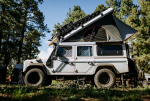Not disparaging at all NickW, I think those are fair critiques as Ineos needs to do a very good job of justifying why this is different, as compared to the other vehicles available. Especially at this asking price. I’ve been neck-deep in this vehicle’s news and information for a long time though, and I think I can speak to what I’ve come to learn is “different” about this vehicle. Of course, having never seen one in person or used one, this entire opinion is based on speculation and trusting of sources, like Ineos, when they say something. So far I have no reason to distrust them, but I’m well aware this could all be marketing BS and the proof will be in the pudding.
But, having watched the pudding be made by the chefs, here’s my thoughts:
First, what vehicles really compare to the Grenadier? The Jeep does, to a degree, as do mid-sized trucks. But the Ineos is playing in a different segment. Solid axles, diff locks, etc. make it go toe-to-toe with the Jeep Rubicon, but it’s payload and capacity numbers are closer to the Superduty/2500-series of HD trucks. So, it’s kind of uniquely positioned like this Venn diagram I drew up:
View attachment 684804
So as far as a market segment, it’s uniquely positioned. In some ways, the only other wagon that truly competes with the Grenadier (on paper) is the new Defender, and that brings me to the question of Analog vs Digital.
The New Defender has more microchips than the Ineos has parts (that’s a tongue-in-cheek exageration bit the point is the ND is very heavily reliant on microprocessors doing what they are designed to do in order to get the vehicle to perform). And it’s VERY good. Probably a bit better than the Ineos off-road, if I’m being honest, and almost certainly better on-road. JLR’s Terrain Response system is
exceptional.
Until it breaks, and you need at least one entire Land Rover dealership (Sometimes more than one, if you are TFL!) to get the car fixed again.
That’s where Ineos started from: How do we build a vehicle that is going to be used in conditions where breakages are a certainty? That means that it’s more than just the “analog vs digital”, it’s about simplicity of field repair and durability of components. Again, this is all what we’ve been told - but the images released seem to back up this approach as it all appears very simple to work on. If I crack a control arm on my New Defender 15 hours from Ulan Batar, Mongolia, am I going to find someone who can weld up the cast aluminum? Probably not.
Let’s contrast this with the new Jeeps because they are closer in concept to what the Ineos is, but even then — Jeeps design philosophy has not been about simplicity, it’s been about preservation of key things (ladder frame, removable roof, solid axles) in the design. But complexity creeps its way in to the jeeps, too - Depending on the engine choice, you may have an auxiliary battery in a new Jeep that, if you mess about the wrong way, can cause you to be stranded in the back of beyond — it happened to the Expedition Overland guys. They had a heck of a time diagnosing and figuring it out because it was a complex add-on that didn’t really contribute to the adventure-ready status of the vehicle at all. There are not supposed to be any systems like that on the Grenadier.
I’m not just talking about features or systems — I’m trying to illustrate that the fundamental approach to design for the Grenadier seems unlike most vehicles available today (with the possible exception of the 70-series but it’s hard to compare the Gren against a 30-year old design). In the Grenadier, the front seats have a cubby hole under them. This is the perfect place for a jacket or rain shell, but no modern 4x4 has a space there. I still use that space on my rig, and the end result is my jacket gets occasionally caught in the seat tracks and rips. The Cubby is a design choice that shows, to me, that Ineos has looked at the needs of the end-user and designed a car for them. And there are quite a few little things like this about it that stand out to me. Even something like the dual horn — being able to give a light “toot” instead of blaring a horn is fantastic when there’s a wild animal in the track; how can we ask the Bison nicely to move on without scaring the crap out of it? I’ve run into that a few times and the answer was “you don’t” if you only have one, really loud horn option. I’m sure the cyclist appreciate the dual volume too

Another example - every modern 4x4 comes with a bloated and slow infotainment system. Ineos says “Nah. They are out of date before they leave the lot. Let’s minimize the built in stuff and rely on people’s phones, since they are gonna do that anyway, and it’s easier to update”. This is a fundamental design choice, not just a convenience, and I think it’s these choices that set them apart. Similarly, the 3D exploding parts diagrams, available for free, are unlike any other manufacturer who usually hide their service and parts ecosystems from the end users.
So it’s less about whether the vehicle is analog or digital — though for simplicity sake and robustness, it’s as analog as a modern car can be — and more about WHY they are trying to go for more analog than digital; it’s because the entire design philosophy appears to be unique in the automotive world today, and that’s why the Gren is shaping up to be the perfect Overlander for me.



